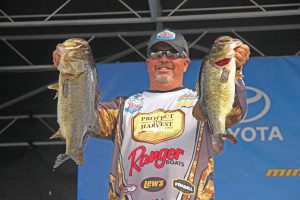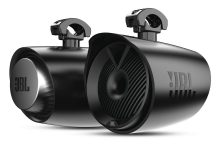This Is The Best Way To Catch Summer Bass On Lake Pleasant
One of the best ways to catch summer bass on Lake Pleasant is with a Carolina rig. I remember back in the day when VanderKooi and his partner came to the scales with a 42-pound limit they caught on Carolina rigs! That’s a 7-pound average!

John Murray has some great tips for fishing Carolina rigs. He says Carolina rig fishing is simple. A large weight and a glass or plastic bead are strung onto the main line. The bead protects the knot from the heavy weight. A swivel is then tied to the end of the line, and a leader, usually of slightly lighter line, is attached to the swivel. Tie on a hook and you’re rigged, Carolina style.
Choosing The Right Weight
To click or not to click, that is the question. When the water is really dirty, or you’re fishing really deep, you may want your rig to make some noise. The noise may alert the bass to the presence of your lure, and let him get close enough to see it.
There are several different ways to get your Carolina rig to make some noise. Brass or stainless steel weights, combined with glass beads or flat brass or steel clickers is one way. John Murray sometimes rigs two brass weights on his line, facing opposite ways, with a bead between them.
If you have ever suspected that fish are hitting your sinker, you’re probably right. Murray once boated a fish that had hit his sinker. The bass had sucked it in and the sinker was wedged on the outside of the fish’s body, right next to the gill. The line was through the mouth. If you think you’re getting a lot of “sinker bites”, you may want to switch to putting rattles in the bait itself.
Structure Is A Factor
The type of structure you are fishing is another factor in your choice of weights. Egg sinkers are ideal for sandy or muddy bottoms–they pull smoothly and kick up dirt that resembles a crawfish scuttling across the bottom. For thick weeds, a pointed weight is better–the point pulls through the weeds or grass more easily than a blunt egg sinker.
For fishing submerged trees or rocks, the big blunt Ultra Steel bullet weights are hard to beat. The shape of the nose allows the sinker to slide over small crevices that a pointed sinker may lodge in, while the hardness of the weight prevents it from being nicked and bent while dragging over rocks. Dragging soft lead weights over rocks and limbs can damage the weight so badly that the hole gets sharp edges that can slice your line.
Carolina Rig Tackle
You are apt to have a lot of line out when you’re fishing a Carolina rig, so the hook is important. An extra-wide gap hook is best, and the hook has to be very sharp, fine, and strong. The more easily the hook penetrates, the better. Don’t scrimp on your swivels, either. The last thing you want is to finally get a hawg on, only to have your swivel snap in two.
Most anglers agree that a longer rod makes casting a Carolina rig much easier. A longer rod not only makes it easier to cast a Carolina rig, it helps you on the hookset by taking up a lot of line when you swing it, so you get the hook moving faster. Since the weight is not on the very end of the line, it can be difficult to cast. Don’t even try to use an overhand cast – instead, hold the rod out to the side like a baseball bat and sling it forward parallel to the surface of the water.
Line And Reel Are Important
Your line and reel are important. You’ll be dragging the Carolina rig in fairly deep water sometimes, so having a fast reel helps you get control of the fish. Some anglers like braid for the main line and mono or fluorocarbon for the leader, but you can use fluorocarbon for the main line, too.
Mono tends to have so much stretch that it’s difficult to set the hook on a big fish, especially in deep water or when the line is going through a lot of weeds. If you like braid and the water you’re fishing is stained or weedy, by all means use braid for both the main line and the leader. In clear water, fluorocarbon is better.
How And Where To Fish The Rig For Big Bass
A Carolina rig is one of the best ways to cover water quickly but still keep your presentation subtle. Long points, flats, channels, and even submerged trees and islands are good targets for a Carolina rig. With the heavy weights you can sling them way out, and even a fast retrieve will attract bites. A Carolina rig should never just be dragged behind the boat. If you just let the movement of the boat drag the lure, you will miss the majority of the bites.
The Easiest Way
The easiest way to fish a Carolina rig is to use the rod to move it. After you make your cast, let the weight free-spool to the bottom. When the line goes slack, reel it up taut then pull the rod sideways and back to drag the weight across the bottom. When you reach the limit of your backswing, reel the line taut as you bring the rod back to the front, then start over again. Keeping the line taut throughout the retrieve and re-wind is essential, because if the line is slack you won’t feel the bite.
While you are pulling the weight with the rod, the lure itself is pulled down and forward through the water. It gets closer to the bottom as it goes, but when you pause and begin to wind up the slack, it allows the lure to pause, then drift upwards until you start to drag the rig again. A lot of times a fish will grab it just as it pauses, and when you start to drag the rig again you will simply feel extra weight. When the rig feels heavy, set the hook!
Don’t Be Shy
Once you catch a fish, don’t be shy about slinging the rig right back out to the same spot. Look for long points, creek channels, ledges, etc. Cruise slowly over these areas and watch your depthfinder carefully for any rock piles, weed beds, trees, or any other cover near the drop-off that would hold fish. Fishing these pieces of cover is the only way to discover if they are holding good fish. And don’t be in too big a hurry to dismiss a spot. You may fish a spot for an hour without a bite, then suddenly get a bunch of big fish right in a row.
Finding a honey hole can be serendipitous, too. When the wind blows you off course, or you are tying on and drifting, keep an eye on the depthfinder. More than one honey hole has been discovered totally by accident. A GPS unit will help you find the place again in the future. It can be difficult to locate a single tree that is far from shore, especially if the water level in the lake fluctuates a lot. Your GPS will take you right back, time after time.
Leader Length, Lures, And Other Subtleties
Leader length has a great effect on the number of bites you get on a Carolina rig. There are several rules of thumb for determining the length of the leader. The slower the bite, the longer the leader is a basic tenet. Leaders of up to six or even seven feet in length are not uncommon when the bite is really slow. Under the toughest conditions, like cold fronts or for suspended fish, a longer leader usually means more bites.
In very dirty water a shorter leader makes it easier for bass to locate the lure once they’ve homed in on the sound of the sinker. Also, if you’re using a very large lure like a 14-inch lizard or worm, a shorter leader gives you more control over the lure, as well as a better feel for the bite.
Creature Baits
By far the most popular Carolina rig baits among big-bass fishermen are lizards, worms, and creature baits. The whole purpose of a Carolina rig is to have the bait float up off the bottom –otherwise you’d Texas-rig it. Lizards and other lures with more surface area float up really well, and sink more slowly.
Inactive, suspended fish can sometimes be tempted by a floating bait that stays at their level. Use a floating lure like one of the “super plastics”. Some pros tie on a tube lure stuffed with a Styrofoam “peanut” to make it float. Senkos can also be killer on sluggish fish.
Carolina Rig: One Of The Most Effective
The key to fishing this rig is to remember where the lure is. When you feel the sinker hitting a tree or a rock, keep in mind that the actual lure may be four to six feet behind it. Don’t ever jerk the sinker out of a tree or a hang-up–pull it loose slowly, and let it fall. That way, the lure will follow along behind and stay in the cover where the fish are.
A Carolina rig is an excellent way to get a soft plastic down to those deep-water mid-summer bass. Fast or slow, deep or shallow, the Carolina rig is one of the most versatile and effective techniques available.
Please scroll to the bottom of any article and leave us your outdoor experiences in the “Comments” section.
More Arizona Fishing Resources
Click here to see a list of AZ Lakes AZ Pros Stories on Western Outdoor Times.
Click here to see a list of AZ Lakes AZ Pros Stories on Arizona Boating And Watersports
Arizona Rivers And Streams Publishers Note
© 2005-2022 Arizona Boating & Watersports. All Rights Reserved.































